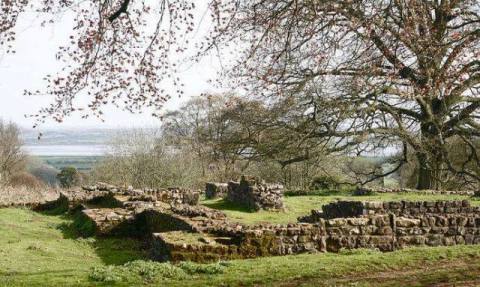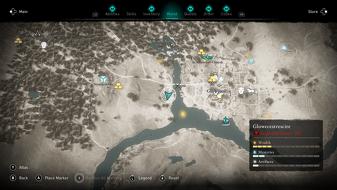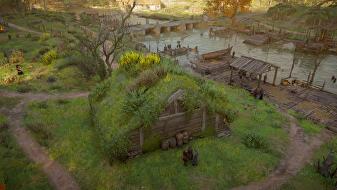You’ve probably seen some of the early-game Easter eggs in Assassin’s Creed Valhalla by now: most notably the Harry Potter house in Lunden, and the tribute to Keith Flint and The Prodigy in Essex. But later in the game you may well stumble across a Lord of the Rings reference – and it’s an Easter egg with a surprising amount of depth.
On the west side of the in-game version of Gloucester (or “Glowecestre”), you’ll stumble upon a community of pagans living in moss-covered homes, and in one of these is a note of some significance. “One of the little folk asked me to make the door smaller, as he wants to keep unruly houseguests from his house,” the note reads. “After the nonsense with the druid last fall, I can see his point.”
Given the placement of the note in an area that looks like Hobbiton, I think it’s safe to assume the druid mentioned in the letter is supposed to be Gandalf, the “little folk” hobbits, and the one complaining is Bilbo Baggins. Oh, and there’s also a ring placed on top of the envelope – just in case you hadn’t already cottoned on at that point. You can’t pick the ring up, but frankly there’s enough going on in Valhalla without the need for an epic quest to destroy the one ring.
The Easter egg itself was a lovely little surprise to find, but having grown up in Gloucestershire I’d previously heard talk that J.R.R. Tolkien had likely influence from his visits to the county – so I decided to investigate a little further. It turns out the location of that Easter egg may not be entirely coincidental, as Tolkien’s work was probably inspired by his visit to Lydney Park in 1929.
Tolkien served as a professor of Anglo-Saxon at Oxford’s Pembroke College between 1925 to 1945, and during this time was invited to work on an archaeological dig in Lydney, Gloucestershire. As part of this, Tolkien examined a Romano-Celtic temple that was later given the name Dwarf’s Hill by the Anglo-Saxons. According to local tradition, those who lived in the area quickly forgot about the Roman origins of the ruins, and began to claim goblins and dwarves lived in the hill.
“It seems probable that Tolkien was inspired in some way by the folklore attached to the hill,” Viscount Bledisloe estate curator Sylvia Jones told the BBC when the Lord of the Rings films were in production. “Seeing the labyrinth of tunnels and little holes in the hillside, it seems so much like Hobbiton, that we think he found some of his inspiration here.”

On top of this, it seems likely that one particular artefact found at Lydney Park really influenced Tolkien, and it’s not hard to see why. A Latin curse tablet found at the site reads “To the god Nodens. Silvanus has lost a ring. He has [vowed] half its value to Nodens. Amongst all who bear the name of Senicianus, refuse thou to grant health to exist, until he bring back the ring to the Temple of Nodens”. As noted by historian Mathew Lyons, this may well refer to the Ring of Silvianus, an actual ring that was dug up in Silchester in 1785. While the story is somewhat different from Tolkien’s, the notion of a cursed ring – and one that needed to be returned to the place of origin to break the spell – is still there.
Tolkien later wrote an academic book on Nodens based on his visit to Lydney Park, but he also began to write out ideas for Lord of the Rings in the late 1920s, and by around summer 1930 had written the first sentence of The Hobbit: “in a hole in the ground there lived a hobbit” (via The Tolkien Society). In short, it seems likely that Lydney did indeed inspire Tolkien’s work.


All this means that the in-game location for the Lord of the Rings Easter egg and the pagan village is a particularly suitable one, and I wouldn’t be surprised if it was a deliberate decision by Ubisoft. So if you’re looking for a Lord of the Rings experience in Assassin’s Creed Valhalla, you could do a lot worse than wandering around Gloucestershire. Sorry – Glowecestrescire.
